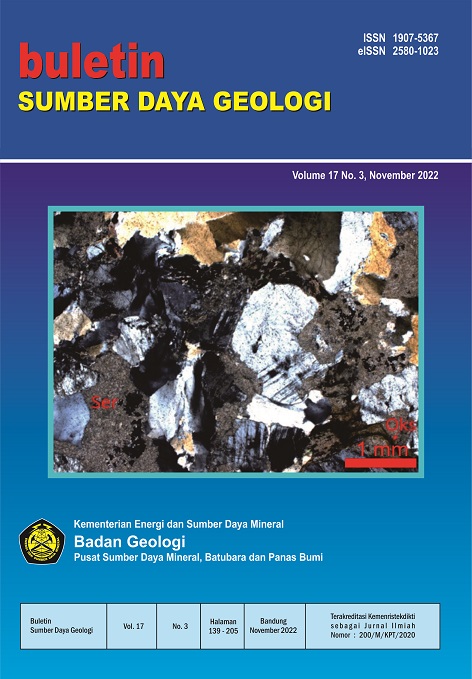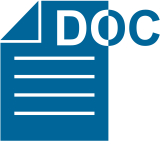PERKIRAAN ULANG CADANGAN MUNGKIN PANAS BUMI TEMPERATUR MENENGAH DI INDONESIA
MEDIUM TEMPERATURE GEOTHERMAL POSSIBLE RESERVE REASSESSMENT IN INDONESIA
Abstract
Accurate information about the value and characteristics of geothermal energy resources and reserves is needed in planning appropriate energy policies to optimize the utilization of geothermal resources in Indonesia. In addition, differences in the results of calculating geothermal energy resources and/or reserves by developers and the government cause the economic calculations of geothermal development projects in particular prospect area to also be different. This study performs a recalculation of geothermal medium temperature resources category by replacing the assumptions of several parameters with the assumptions of best practice parameters used in several literatures. The five parameters are thermal calculations contained in the fluid, final reservoir temperature, water saturation, electricity conversion factor and generating capacity factor. The results of this recalculation resulted in a geothermal resource value that was different from the results of the Geological Agency's calculations. The percentage difference between the calculations of the Geological Agency and this study indicates a strong correlation with reservoir temperature as shown by the R2 value of 85%. This strong correlation indicates that there is a systematic difference, which is suspected because in the Geology Agency's calculations it is assumed that there is a change in the water phase from the liquid phase to the vapor phase. The results of recalculation using the correlation equation with the reservoir temperature as an input resulted in the value of geothermal resources reduction by 27% or 940 MWe from the results of the Geological Agency's calculations. The recalculation result of medium temperature geothermal resources which previously reached 3,482 MWe reduced to a total of 2,541 MWe.
Downloads
References
Ashat, A., & Saptadji, N. M. (2002). Correlations for Thermodynamic Properties of Pure Water At Saturation Condition. In Teknik Panas Bumi (p. 305). ITB.
Badan Standardisasi Nasional. (1999). Metode Estimasi Potensi Energi Panas Bumi. SNI 13-6171-1999. Badan Standardisasi Nasional. Jakarta.
Badan Standardisasi Nasional. (2000). Angka Parameter dalam Estimasi Potensi Energi Panas Bumi. SNI 13-6482-2000. Badan Standardisasi Nasional. Jakarta.
Badan Standardisasi Nasional. (2017). Klasifikasi Sumber Daya dan Cadangan Energi Panas Bumi Indonesia. SNI 6009:2017. Badan Standardisasi Nasional. Jakarta.
Badan Standardisasi Nasional. (2018a). Metode Estimasi Potensi Energi Panas Bumi. SNI 6169:2018. Badan Standardisasi Nasional. Jakarta.
Badan Standardisasi Nasional. (2018b). Parameter dalam Estimasi Potensi Energi Panas Bumi. SNI 6482:2018. Badan Standardisasi Nasional. Jakarta.
Ciriaco, A. E., Zarrouk, S. J., & Zakeri, G. (2020). Geothermal resource and reserve assessment methodology: Overview, analysis and future directions. Renewable and Sustainable Energy Reviews, 119, 109515. https://doi.org/10.1016/J.RSER.2019.109515
Danar, A. (2010). Keputusan Investasi Panas Bumi Di Indonesia. In Energi Panas Bumi Di Indonesia (pp. 61–179). Badan Geologi.
Direktorat Panas Bumi. (2014). Penyiapan Data dan Informasi Awal untuk Penyusunan Masterplan Panas Bumi.
Kaya, E., Zarrouk, S. J., & O’Sullivan, M. J. (2011). Reinjection in geothermal fields: A review of worldwide experience. Renewable and Sustainable Energy Reviews, 15(1), 47–68. https://doi.org/10.1016/j.rser.2010.07.032
Kementerian ESDM. (2017). Peraturan Menteri Energi dan Sumber Daya Mineral Nomor 37 Tahun 2017 Tentang Wilayah Kerja Panas Bumi Untuk Pemanfaatan Tidak Langsung.
Lawless, J. (2007). Discussion Paper on Guidelines for Geothermal Reserves Definition.
Lawless, J. v, Ward, M., & Beardsmore, G. (2010). The Australian code for geothermal reserves and resources reporting: practical experience. Proceedings of the World Geothermal Congress.
Nugraha, H., Saefulhak, Y., & Pangaribuan, B. (2017). A Study on the Impacts of Incentives to the Geothermal Energy Electricity Price in Indonesia using Production-based Cost Approach. The 5th Indonesia International Geothermal Convention & Exhibition (IIGCE).
Pemerintah Indonesia. (2014). Undang-Undang Nomor 21 tahun 2014 tentang Panas Bumi.
Pusat Sumber Daya Mineral Batubara Panas Bumi. (2022). Peta Potensi dan Distribusi Panas Bumi Indonesia.
Quinao, J. J., & Zarrouk, S. J. (2014). A Review of the Volumetric Stored-Heat Resource Assessment: One Method, Different Result. Proceedings of 36th New Zealand Geothermal Workshop, 24–26.
Quinlivan, P. (2009). Assessment of Current Costs of Geothermal Power Generation in New Zealand (2007 Basis). New Zealand Geothermal Association, 74.
Rogers, G. F. C., & Mayhew, Y. R. (1995). Thermodynamic and transport properties of fluids. John Wiley & Sons.
Saptadji, N. M. (2001). Teknik Panas Bumi. Bandung, Penerbit ITB.
Sarmiento, Z. F., & Bjornsson, G. (2007). Geothermal resource assessment-volumetric reserves estimation and numerical modelling. Reykjavik, Iceland: United Nations University-Geothermal Training Programme and La Geo.
Sarmiento, Z. F., Steingrímsson, B., & Axelsson, G. (2013). Volumetric resource assessment. Proceedings of the Short Course V on Conceptual Modelling of Geothermal Systems, Santa Tecla, El Salvador, 2.
The Australian Geothermal Reporting Code Committee (AGRCC). (2010). Australian Code for Reporting of Exploration Results, Geothermal Resources and Geothermal Reserves - The Geothermal Reporting Code.
Tortike, W. S., & Ali, S. M. F. (1989). Saturated-Steam-Property Functional Correlations for Fully Implicit Thermal Reservoir Simulation. SPE Reservoir Engineering, 4(04), 471–474. https://doi.org/10.2118/17094-PA
West Japan Engineering Consultant. (2017). Review of the Target of Geothermal Development Plan.
Williams, A. F., Lawless, J. v, Ward, M. A., Holgate, F. L., & Larking, A. (2010). A code for geothermal resources and reserves reporting. Proceedings World Geothermal Congress.
Williams, C. F. (2004). Development of revised techniques for assessing geothermal resources. Proceedings, 29th Workshop on Geothermal Reservoir Engineering, Stanford University.
Williams, C. F., Reed, M., & Mariner, R. H. (2008). A Review of Methods Applied by the US Geological Survey in the Assessment If Identified Geothermal Resources. (p. 27). US Department of Interior, US Geological Survey.
Zarrouk, S. J., & Moon, H. (2014). Efficiency of geothermal power plants: A worldwide review. Geothermics, 51, 142–153. https://doi.org/10.1016/j.geothermics.2013.11.001
Zarrouk, S. J., & Simiyu, F. (2013). A review of geothermal resource estimation methodology. Proceedings, New Zealand Geothermal Workshop, Rotorua.
Copyright (c) 2023 Buletin Sumber Daya Geologi

This work is licensed under a Creative Commons Attribution-NonCommercial-ShareAlike 4.0 International License.
Authors whose manuscripts are published agree to the following terms:
The publication rights of all journal manuscript materials published on the Buletin Sumber Daya Geologi website are held by the editorial board with the knowledge of the author (moral rights remain with the manuscript’s author).
The formal legal provisions for access to digital articles in this electronic journal are subject to the terms of the Creative Commons Attribution-ShareAlike (CC BY-SA) license. This means that Buletin Sumber Daya Geologi has the right to store, convert media/formats, manage in the form of a database, maintain, and publish the article without requesting permission from the author, as long as the author’s name is cited as the copyright holder.
Manuscripts published in both print and electronic formats are open access for educational, research, investigative, and library purposes. Beyond these purposes, the editorial board is not responsible for any violations of copyright law.















